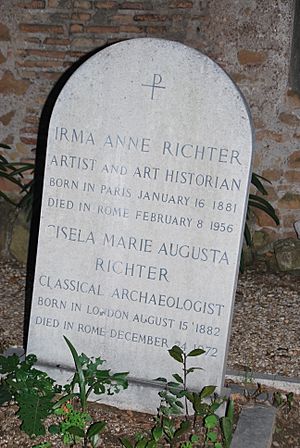Gisela Richter facts for kids
Gisela Marie Augusta Richter (14 or 15 August 1882 – 24 December 1972) was a classical archaeologist and art historian. She was a prominent figure and an authority in her field.
Contents
Early life
Gisela Richter was born in London, England, the daughter of Jean Paul and Louise (Schwaab) Richter. Both of her parents and her sister, Irma, were art historians specialised in Italian Renaissance. She was educated at Maida Vale School, one of the finest schools for women at the time. She decided to become a classical archaeologist while attending Emmanuel Loewy's lectures at the University of Rome around 1896. In 1901, she began attending Girton College at the University of Cambridge. At Girton, Richter's six closest friends included Lady Dorothy Georgiana Howard, the daughter of the 9th Earl and "Radical Countess" of Carlisle, and future candidate for Roman Catholic Sainthood Anna Abrikosova. Richter was included when all seven girls were brought by Lady Dorothy to Castle Howard and Naworth Castle as honored guests during college vacations.
Richter left Girton in 1904 without a degree, since women at the time could not graduate and spent a year at the British School at Athens between 1904 and 1905. Richter moved to the U.S. in 1905 and became a naturalized American citizen in 1917.
Career
Richter joined the Metropolitan Museum of Art in New York as an assistant in 1905, where she was asked to create a catalogue for a collection of Greek vases recently acquired by the Met from the Canessa Brothers, the famous European art dealers. She became assistant curator in 1910, promoted to associate curator in 1922, and curator of Greek and Roman art in 1925, a position held until 1948 when she retired. Richter became honorary curator until her death in 1972. She became the first woman to hold the title of 'curator' at the Met when she was appointed to the post in 1925. As curator, she was one of the most influential people in classical art history at the time.
Richter lectured at Columbia University, Yale University, Bryn Mawr College, and Oberlin College. As author of numerous popular books on classical art, she had a great influence on the general public's understanding and appreciation of the subject. In 1944, she received the Achievement Award from the American Association of University Women. In 1952, she was awarded the degree of Doctor of Letters by the University of Oxford. In 1968, she received the Gold Medal Award for Distinguished Archaeological Achievement from the Archaeological Institute of America.
She was elected as a member of the American Philosophical Society in 1942.
Death and legacy
In 1952, Richter moved to Rome, Italy, where she died in 1972. She is buried in Rome's Cimitero acattolico. Writing 30 years after Richter's death, Camille Paglia paid tribute to her "for her clarity and rigor of mind; her fineness of sensibility and connoisseurship; her attention to detail and her power of observation and deduction; her mastery of form and design".
Necrology
- Frank E. Brown, Studi Etruschi 41 (1973)
- Homer Thompson, American Philosophical Society-Yearbook (1973)
- Cornelius C. Vermeule III, The Burlington Magazine 115 (1973)
See also
 In Spanish: Gisela M. A. Richter para niños
In Spanish: Gisela M. A. Richter para niños


